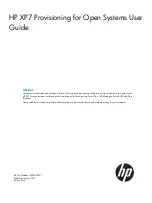
1 Introduction to provisioning
Abstract
Provisioning a storage system requires balancing the costs of the solution with the benefits that the
solution provides. The following is an overview of provisioning strategies that you can implement
on the HP XP7 Storage to support your business.
About provisioning
Provisioning is a method of managing storage system devices or volumes. Some provisioning
methods are host-based, while others use existing storage system capabilities such as concatenated
array groups. Some provisioning methods are hardware-based, and others are software-based.
Each technique has its particular use and benefit, for example, capacity, reliability, performance,
or cost considerations, in a given storage environment. Used in the wrong scenario, each can be
expensive, awkward, time consuming to configure and maintain, and can be potentially error
prone. Your support representatives are available to help you configure the highest quality solution
for your storage environment.
Provisioning strategies falls into two fundamental categories:
•
“Basic provisioning” (page 13)
(or traditional provisioning). Basic provisioning includes logical
devices (LDEVs) and custom-sized volumes.
•
“Thin Provisioning Overview” (page 16)
(or virtual provisioning). Thin provisioning includes
pooling physical storage and creating logical devices for hosts.
Basic provisioning
Several basic provisioning techniques traditionally are used to manage storage volumes. These
strategies are useful in specific scenarios based on user needs, such as whether you use open or
mainframe storage systems, or you prefer manual or automated control of your storage resources.
Basic provisioning relies on carving up physical storage into smaller units. Custom sizing is possible,
and requires using Virtual LUN software.
Basic provisioning includes:
•
“Fixed-sized provisioning” (page 13)
•
“Custom-sized provisioning” (page 15)
Fixed-sized provisioning
Two traditional fixed-size host-based volume management methods typically are used on open
systems to organize storage space on a server. One method is the direct use of physical volumes
as devices for use either as raw space or as a local or clustered file system. These are fixed-size
volumes with a fixed number of disks, and as such, each has a certain inherent physical random
input/output operation per second (IOPS) or sequential throughput (megabytes per second) capacity.
A System Administrator manages the aggregate server workloads against them. As workloads
exceed the volume's available space or its IOPS capacity, the user contents are manually moved
onto a larger or faster (more spindles) volume, if possible.
The following figure illustrates a simple fixed-size provisioning environment using individual LU
volumes on a host:
About provisioning
13














































